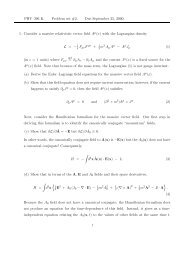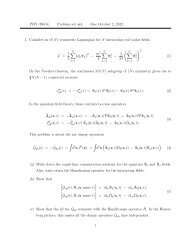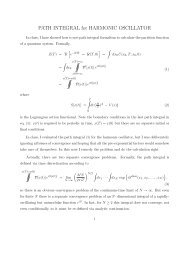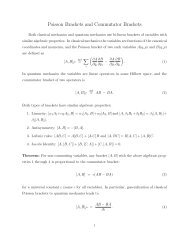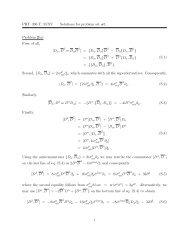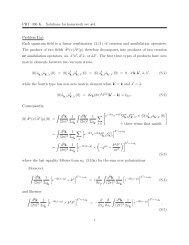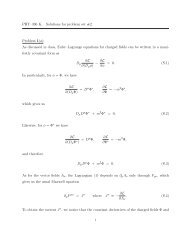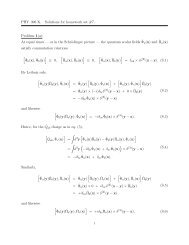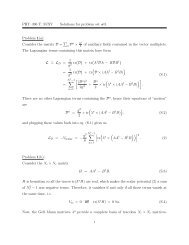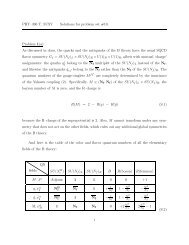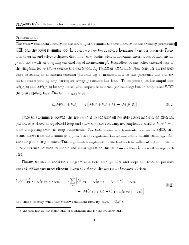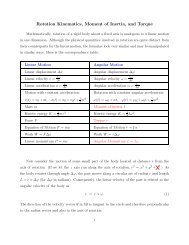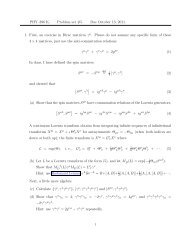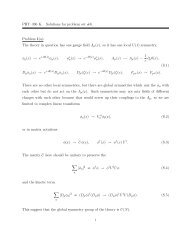PHYâ396 K. Solutions for problem set #4. Problem 1(a): First of all, a ...
PHYâ396 K. Solutions for problem set #4. Problem 1(a): First of all, a ...
PHYâ396 K. Solutions for problem set #4. Problem 1(a): First of all, a ...
- No tags were found...
Create successful ePaper yourself
Turn your PDF publications into a flip-book with our unique Google optimized e-Paper software.
PHY–396 K. <strong>Solutions</strong> <strong>for</strong> <strong>problem</strong> <strong>set</strong> <strong>#4.</strong><strong>Problem</strong> 1(a):<strong>First</strong> <strong>of</strong> <strong>all</strong>, a point <strong>of</strong> notation: In class, I used denoted the original scalar fields ϕ i (x) (<strong>for</strong>i = 1, . . . , N), and σ(x) was the shifted field σ(x) = ϕ N (x) − v. But in this <strong>problem</strong>, thefirst N − 1 = 3 scalar fields are denoted π i (x) while σ(x) is the un-shifted field playing therole <strong>of</strong> π 4 (x). The shifted field σ(x) − 〈σ〉 will be c<strong>all</strong>ed δσ(x).And now, the solution. The linear sigma model has scalar potentialV (σ, π˜) = λ 8(σ 2 + π˜2 − f 2) 2− λf 2 β × σ. (S.1)All stationary points <strong>of</strong> this potential are solutions to equationsand∂V∂π˜= λ 2(σ 2 + π˜2 − f 2) × = 0 (S.2)π˜∂V∂σ = λ (σ 2 +2π˜2 − f 2) × σ − λf 2 β = 0. (S.3)For f ≠ 0, the second equation (S.3) requires σ 2 + π˜2 − f 2 ≠ 0 and then the first equation(S.2) immediately leads to π˜= 0 — <strong>all</strong> stationary points are along the σ axis <strong>of</strong> the R 4 fieldspace. Plugging π˜= 0 back into the eq. (S.3), we obtain a cubic equation <strong>for</strong> the σ,σ 3 − f 2 σ − 2f 2 β = 0. (S.4)For sm<strong>all</strong> β > 0 this equation has three real solutions, namelyσ 1 ≈ −2β, σ 2 ≈ −f + β, σ 3 ≈ +f + β. (S.5)Now let’s find out which <strong>of</strong> this stationary points is a minimum.At π˜= 0 the second1
derivatives <strong>of</strong> the potential are∂ 2 V∂σ 2 = λ(3σ 2 − f 2 ),∂ 2 V∂π i ∂π j= λ(σ 2 − f 2 )δ ij ,∂ 2 v∂σ∂π i= 0. (S.6)Evaluating these second derivatives <strong>for</strong> the three stationary points (S.5), we find@ σ 1 : V ′′σσ < 0 and V ′′ππ < 0 =⇒ maximum,@ σ 2 : V ′′σσ > 0 and V ′′ππ < 0 =⇒ saddle point,@ σ 3 : V ′′σσ > 0 and V ′′ππ > 0 =⇒ minimum.(S.7)Thus, V (σ, π˜) has a unique minimum at = 0, σ = σ 3 ≈ f + β, exactly as in eq. (6.2).π˜Q.E.D.<strong>Problem</strong> 3(b):Let us shift the σ field by its vacuum expectation value 〈σ〉 = σ 3 ,σ(x) = 〈σ〉 + δσ(x).(S.8)Expanding the scalar potential into powers <strong>of</strong> the π˜and δσ fields, we haveV (π˜, δσ) = λ 8(π˜2 + ( σ 2 = 〈σ〉 2 + 2 〈σ〉 δσ + δσ 2) − f 2) 2− λf 2 β ( σ = 〈σ〉 + δσ )= const + V 1 + V 2 + V 3 + V 4(S.9)whereV 1 = λ 2 × ( 〈σ〉 2 − f 2) × 〈σ〉 × δσ − λβf 2 × δσ = 0 (S.10)(cf. eq. (S.3)) since we are expanding around the minimum V ,V 2 = λ (〈σ〉 2 − f 2) × ( 4π˜2 + δσ 2) + λ 2 〈σ〉2 × δσ 2 ,= λ (〈σ〉 2 − f 2) ×4π˜2 + λ (3 〈σ〉 2 − f 2) × δσ 2 ,4andV 3V 4= λ 〈σ〉 × δσ × ( π˜2 + δσ 2) (S.11),2= λ 8 × ( π˜2 + δσ 2) 2 .2
Now let’s expand the whole Lagrangian into powers <strong>of</strong> π˜(x) and δσ(x). ClearlyL = L kin − V = L free + L int (S.12)whereL free = L kin − V 2 (π˜, δσ)[ (∂µ δσ) 2=− λ (3 〈σ〉 2 − f 2) ]× δσ 22 4+[ (∂µ π˜) 22− λ 4(〈σ〉 2 − f 2) ]× π˜2(S.13)describes the free π˜and δσ fields, andL int = −V 3 (π˜, δσ) − V 4 (π˜, δσ) (S.14)describes their interactions.(S.13): the pion mass 2 isThe particles’ masses follow from the quadratic LagrangianM 2 π = λ 2(〈σ〉 2 − f 2) = λβf 2〈σ〉≈ λβf(S.15)— where the second equality follows from 〈σ〉 satisfying eq. (S.3), and the last, approximateequality follows from 〈σ〉 = σ 3 ≈ f, — while the σ’s mass 2 isM 2 σ = λ 2(3 〈σ〉 2 − f 2) = λ 〈σ〉 2 + M 2 π. (S.16)For β ≪ f we have 〈σ〉 ≈ f and hence M 2 σ ≈ λf 2 ≫ M 2 π.Q.E.D.<strong>Problem</strong> 3, the non-linear limit:In the strong-coupling limit λ → ∞, the first term in the potential (S.1) becomes a constraintσ 2 (x) + π˜2 (x) ≡ f 2 . (S.17)Solving the constraint eliminates the independent σ field from the theory asσ(x) =√f 2 − π˜2 (x) , (S.18)and we are left with the non-linear sigma model <strong>for</strong> the three π i (x) fields.The kinetic3
Lagrangian <strong>for</strong> this model follows fromL kin = 1 2 (∂ µπ˜) 2 + 1 2 (∂ µσ) 2 = 1 2 G ij(π˜) ∂ µ π i ∂ µ π j (S.19)(implicit sum over i and j) whereG ij (π˜) = δ ij + π i π jf 2 − 2 π˜. (S.20)As to the potential, the SO(4)–symmetric leading term vanishes, while the perturbationyieldsV= −λf 2 β × σ = −λf 2 β × √ f 2 − π˜2 = const + 1 2λfβ × π˜2 + O(π˜4 ). (S.21)Extracting the quadratic terms from eqs. (S.19) and (S.21), we obtain the free LagrangianL free = 1 2 (∂ µπ˜) 2 − 1 2 λfβ × π˜2 , (S.22)which clearly describes 3 fields π i <strong>of</strong> common mass M 2 π = λfβ.<strong>Problem</strong> 2(a):given Φ → e +iθ U L ΦU † R , (6.5)we have Φ † → e −iθ U R Φ † U † L , (S.23)hence Φ † Φ → U R (Φ † Φ)U † R , (S.24)(Φ † Φ ) 2 → UR Φ † ΦU † R U RΦ † ΦU † R = U R(Φ † Φ ) 2 U†R , (S.25)(likewise Φ † Φ ) n (→ UR Φ † Φ ) n U†R∀n = 1, 2, 3, . . . , (S.26)and there<strong>for</strong>e<strong>all</strong> traces tr( (Φ † Φ ) n ) are invariant under (6.5), (S.27)thanks to the cyclic invariance rule <strong>for</strong> traces, tr ( U R XU † ) (R = tr XU†R U ( )R)= tr X <strong>for</strong> anyX = ( Φ † Φ ) n . Consequently, the scalar potential (6.4) is invariant under symmetries (6.5).4
For the global symmetries where e iθ , U L , and U R do not depend on x, the kinetic termin (6.3) is also invariant. Indeed,<strong>for</strong> constant e iθ , U L , U R ,∂ µ Φ → e +iθ U L (∂ µ Φ)U † R ,∂ µ Φ † → e −iθ U R (∂ µ Φ † )U † L ,(S.28)∂ µ Φ † ∂ µ Φ → U R (∂ µ Φ † ∂ µ Φ)U † R ,and tr ( ∂ µ Φ † ∂ µ Φ ) is invariant.Altogether, the whole Lagrangian (6.3) is invariant,Q.E.D.<strong>Problem</strong> 2(⋆):The kinetic term in (6.3) and the last two terms in the potential (6.4) have a much biggersymmetry than G, namely SO(2N 2 ), which does not care <strong>for</strong> the matrix structure <strong>of</strong> theΦ(x) and treats it as 2N 2 real component fields. Indeed,(tr Φ † Φ) = ∑ i,j∣∣Φ ji∣∣ 2= ∑ i,j( ( ) 2 ( ) ) 2Re Φ ji + Im Φ ji(S.29)is invariant under <strong>all</strong> SO(2N 2 ) “rotations” <strong>of</strong> the components, and so is the kinetic term.On the other hand, the tr ( Φ † Φ Φ † Φ ) in the potential does depend on the packing <strong>of</strong>2N 2 real components into a complex N × N matrix, and it is this term which reduces theinternal symmetry group <strong>of</strong> the theory to G = SU(N) × SU(N) × U(1).Proving that <strong>all</strong> the SO(2N 2 )/G symmetries are broken by the quartic trace term is anon-trivial exercise in group theory rather than field theory. You do not have to do it aspart <strong>of</strong> this homework <strong>set</strong>, and I am not writing down the pro<strong>of</strong> here.<strong>Problem</strong> 2(b):Given the eigenvalues (κ 1 , . . . , κ N ) <strong>of</strong> the Φ † Φ matrix, the invariant traces (S.27) obtain astr( (Φ † Φ ) n ) =N∑κ n i .i=1(S.30)5
Consequently, the scalar potential isV = α 2(∑κ 2 i + β ∑2iiκ i) 2+ m 2 ∑ iκ i .(S.31)Now let’s minimize this potential. Since the matrix Φ † Φ cannot have any negativeeigenvalues, we are looking <strong>for</strong> a minimum <strong>of</strong> V (κ 1 , . . . , κ N ) under constraints κ i ≥ 0. Thisrequires∀i = 1, . . . , N,either κ i ≥ 0 and ∂V∂κ i= 0, or else κ i = 0 and ∂V∂κ i> 0, (S.32)where∂V∂κ i= ακ i + m 2 + β ∑ jκ j .(S.33)The solutions <strong>of</strong> these equations are as follows:• For α > 0, β > 0, and m 2 > 0, the only solution is κ 1 = · · · κ N = 0 and hence 〈Φ〉 = 0.• For α > 0, β > 0, and m 2 < 0, the only solutions is (6.6) and hence 〈Φ〉 = C × aunitary matrix. We sh<strong>all</strong> focus on this regime in parts (c–e) <strong>of</strong> this <strong>problem</strong> and in<strong>problem</strong> 3.• For α < 0 or β < 0, the situation is more complicated:— When α + β < 0 or α + Nβ < 0, the scalar potential (6.4) is unbounded frombelow and the theory is sick.— When α > 0 and β < 0 but α + Nβ > 0, the solutions are similar to the β > 0case: For m 2 > 0 <strong>all</strong> κ i = 0, while <strong>for</strong> m 2 < 0 the κ i are as in eq. (6.6).— When β > 0 and α < 0 but α + β > 0, there is only one 〈φ〉 = 0 solution <strong>for</strong>m 2 > 0, but there are N distinct solutions <strong>for</strong> m 2 < 0, namely <strong>for</strong> k = 1, 2, . . . , N,κ 1 = · · · = κ k = −m2α + kβ > 0, κ k+1 = · · · = κ N = 0 (S.34)(modulo permutations <strong>of</strong> the eigenvalues). The deepest minimum <strong>of</strong> V correspondsto the k = 1 solution.6
<strong>Problem</strong> 2(c):Let’s act with some SU(N) L × SU(N) R × U(1) symmetry (6.5) on the vacuum expectationvalues (6.7):〈Φ〉 = C × 1 N×N → e iθ U L 〈Φ〉 U † R = C × eiθ U L U † R . (S.35)Clearly, to keep the VEVs 〈Φ〉 invariant, we neede iθ U L U † R = 1 N×N (S.36)and henceU R = e iθ × U L . (S.37)Moreover, since the U L and U R matrices have unit determinants, this meanse iθ = 1 and U L = U R ∈ SU(N). (S.38)In other words, the unbroken symmetry group is SU(N) which acts on the scalar fields asΦ(x) → UΦ(x) U † , U ∈ SU(N). (S.39)<strong>Problem</strong> 2(d):In terms <strong>of</strong> the shifted fields (6.8),∂ µ Φ = 1 √2(∂ µ ϕ 1 + i∂ µ ϕ 2 ) , ∂ µ Φ † = 1 √2(∂ µ ϕ 1 − i∂ µ ϕ 2 ) ,(S.40)hence the kinetic term in the Lagrangian becomestr ( ∂ µ Φ † ∂ µ Φ ) = 1 2 tr(∂ µϕ 1 ∂ µ ϕ 1 ) + 1 2 tr(∂ µϕ 2 ∂ µ ϕ 2 ).(S.41)As to the potential terms, we haveΦ † Φ = C 2 × 1 N×N+ C × ( δΦ † + δΦ) + δΦ † δΦ= C 2 × 1 N×N + √ 2C × ϕ 1 + 1 2 ϕ2 1 + 1 2 ϕ2 2 + i 2 [ϕ 1, ϕ 2 ](S.42)and consequentlytr ( Φ † Φ ) = NC 2 + √ 2C tr(ϕ 1 ) + 1 2 tr(ϕ2 1) + 1 2 tr(ϕ2 2), (S.43)7
tr 2( Φ † Φ ) = N 2 C 4 + 2 √ 2NC 3 tr(ϕ 1 ) + 2C 2 tr 2 (ϕ 1 ) + NC 2 ( tr(ϕ 2 1) + tr(ϕ 2 2) )+ √ 2C tr(ϕ 1 ) × ( tr(ϕ 2 1) + tr(ϕ 2 2) ) + 1 (4 tr(ϕ21 ) + tr(ϕ 2 2) ) 2(S.44)( (Φtr † Φ ) ) 2= NC 4 + 2 √ 2C 3 tr(ϕ 1 ) + 3C 2 tr(ϕ 2 1) + C 2 tr(ϕ 2 2)+ √ 2C tr(ϕ 3 1) + √ 2C tr(ϕ 1 ϕ 2 2)+ 1 4 tr(ϕ4 1) + 1 4 tr(ϕ4 2) +2 3 tr(ϕ2 1ϕ 2 2) − 1 2 tr(ϕ 1ϕ 2 ϕ 1 ϕ 2 ). (S.45)Plugging <strong>all</strong> these <strong>for</strong>mulae into the potential (6.4) and expanding in powers <strong>of</strong> ϕ 1 and ϕ 2 ,we obtainV = const + V 1 + V 2 + V 3 + V 4 (S.46)whereV 1 = √ 2C × (m 2 + βNC 2 + αC 2 ) × tr(ϕ 1 ) = 0 (S.47)〈〈 because m 2 + (α + Nβ)C 2 = 0 〉〉V 2 = βC 2 × tr 2 (ϕ 1 ) + 1 2 (m2 + βNC 2 + 3αC 2 ) × tr(ϕ 2 1)+ 1 2 (m2 + βNC 2 + αC 2 ) × tr(ϕ 2 2)= βC 2 × tr 2 (ϕ 1 ) + αC 2 tr(ϕ 2 1) + 0, (S.48)V 3= βC()√ × tr(ϕ 1 ) × tr(ϕ 2 1) + tr(ϕ 2 2)2+ αC ()√ × tr(ϕ 3 1) + tr(ϕ 1 ϕ 2 2) , (S.49)2V 4 = β () 2tr(ϕ 281) + tr(ϕ 2 2)+ α ()tr(ϕ 481) + tr(ϕ 4 2) + 6 tr(ϕ 2 1ϕ 2 2) − 2 tr(ϕ 1 ϕ 2 ϕ 1 ϕ 2 ) . (S.50)Combining the quadratic part (S.48) <strong>of</strong> this potential with the kinetic terms (S.41), wearrive atL 2 = 1 2 tr(∂ µϕ 1 ∂ µ ϕ 1 ) − βC 2 × tr 2 (ϕ 1 ) − αC 2 tr(ϕ 2 1) + 1 2 tr(∂ µϕ 2 ∂ µ ϕ 2 ) (S.51)which gives us the mass spectrum <strong>of</strong> the theory: the ϕ 1 (x) matrix <strong>of</strong> fields is massive and the8
ϕ 2 (x) matrix is massless. Each matrix is N ×N and hermitian, so it contains N 2 independentreal scalar fields, which give rise to N 2 particles. Altogether, the spectrum comprises:• N 2 massless particles from the ϕ 2 (x) matrix.• N 2 − 1 massive particles with M 2 = 2αC 2 from the traceless part <strong>of</strong> the ϕ 1 (x) matrix.• One more massive particle with M 2 = 2(α + Nβ)C 2 = −2m 2 from the trace <strong>of</strong> ϕ 1 (x).To see where the values <strong>of</strong> the masses come from, let’s decompose the ϕ 1 matrix intothe pure trace plus the traceless part,ξ(x) def = tr(ϕ 1(x))√Nand ˜ϕ 1 (x) def = ϕ 1 (x) − ξ(x) √N× 1 N×N =⇒ tr( ˜ϕ 1 ) ≡ 0. (S.52)Consequently,tr 2 (ϕ 1 ) = N × ξ 2 , tr(ϕ 2 1) = ξ 2 + tr( ˜ϕ 2 1), (S.53)likewi<strong>set</strong>r ( ∂ µ ϕ 1 ∂ µ ϕ 1)= ∂µ ξ ∂ µ ξ + tr ( ∂ µ ˜ϕ 1 ∂ µ ˜ϕ 1),so the free Lagrangian (S.51) becomesL 2 = 1 2 (∂ µξ) 2 − 2(βC 2 N + αC 2 ) × 1 2 ξ2+ 1 2 tr( (∂ µ ˜ϕ 1 ) 2) − 2αC 2 × 1 2 tr( ˜ϕ2 1)(S.54)+ 1 2 tr( (∂ µ ϕ 2 ) 2) − 0 × 1 2 tr(ϕ2 2)where <strong>all</strong> the masses are manifest.<strong>Problem</strong> 2(e):The unbroken SU(N) symmetry acts on the scalar fields according to eq. (S.39), or in terms<strong>of</strong> the shifted fields,ϕ 1 (x) → Uϕ 1 (x) U † , ϕ 2 (x) → Uϕ 2 (x) U † . (S.55)To make the SU(N) multiplet structure manifest, let’s decompose both ϕ 1 and ϕ 2 into their9
traceless parts and pure traces along the lines <strong>of</strong> eq. (S.52),ϕ 1 (x) = ξ 1(x)√N×1 N×N + ˜ϕ 1 (x), ϕ 2 (x) = ξ 2(x)√N×1 N×N + ˜ϕ 2 (x), tr( ˜ϕ 1 ) ≡ tr( ˜ϕ 2 ) ≡ 0.(S.56)With this decomposition, the ξ 1 and the ξ 2 are both invariant under the SU(N) — whichputs each <strong>of</strong> them into its own singlet multiplet — while the each <strong>of</strong> the traceless parts ˜ϕ 1and ˜ϕ 2 makes each own adjoint multiplet.This multiplet structure agrees with the masses we obtained in part (d). Indeed, <strong>all</strong>N 2 − 1 members <strong>of</strong> the adjoint multiplet ˜ϕ 1 have the same mass 2αC 2 , while the singlet ξ 1has a different mass 2(α + Nβ)C 2 .On the other hand, both the adjoint multiplet ˜ϕ 2 and the singlet ξ 2 are massless. Thereason <strong>for</strong> this degeneracy goes beyond the un-broken SU(N) symmetry; instead, both the˜ϕ 2 and the ξ 2 are Goldstone bosons <strong>of</strong> the spontaneously broken symmetries inG/H =() /SU(N) L × SU(N) R × U(1) SU(N) .(S.57)Specific<strong>all</strong>y, the singlet ξ 2 is the Goldstone boson <strong>of</strong> the broken U(1) symmetry. Indeed, theU(1)’s generator commutes with <strong>all</strong> the other generators, so it belongs in its own singlet <strong>of</strong>the symmetry, and the corresponding Goldstone particle should also be a singlet.Now consider the non-abelian generators. Generators TL a <strong>of</strong> the SU(N) L <strong>for</strong>m an adjointmultiplet <strong>of</strong> the SU(N) L , but are invariant under the SU(N) R . Likewise, generators TR a <strong>of</strong>the SU(N) R <strong>for</strong>m an adjoint multiplet <strong>of</strong> the SU(N) R , but are invariant under the SU(N) L .In other words, under an (U L , U R ) ∈ SU(N) L × SU(N) R they trans<strong>for</strong>m asT a L → U LT a L U † L , T a R → U RT a R U † R . (S.58)When the SU(N) L × SU(N) R is broken down to a single SU(N) spanning U L = U R = U,both TL a and T R a trans<strong>for</strong>m asT a L → UT a L U † , T a R → UT a R U † , (S.59)which puts them into two adjoint multiplets <strong>of</strong> the unbroken SU(N). Equivalently, we may10
<strong>for</strong>m two adjoint multiplets out <strong>of</strong>T a V = T a L + T a R and T a A = T a L − T a R , (S.60)which act on the scalar fields according toT a V Φ = i 2 [λa , Φ], T a A Φ = i 2 {λa , Φ}. (S.61)The TV a generate the unbroken SU(N) symmetry, cf. eq. (S.39). The T A a generators arespontaneously broken, hence there should be an adjoint multiplet <strong>of</strong> massless Goldstonebosons. And indeed there is — the ˜ϕ 2 .<strong>Problem</strong> 3(a):When a gauge symmetry is spontaneously broken, the gauge fields acquire masses — whichcome from the gauge-covariant kinetic terms <strong>for</strong> the scalar fields with non-zero VEVs (vacuumexpectation values). The simplest way to separate the vector mass terms from shiftedscalars’ kinetic energies and scalar-vector interactions is to freeze the scalar fields to theirVEVs. Indeed, let’s freeze Φ(x) ≡ 〈Φ〉 = C × 1 N×N . Then according to eq. (9),D µ 〈Φ〉 = ig ′ B µ 〈Φ〉 + igL µ 〈Φ〉 − ig 〈Φ〉 R µ= ig ′ C B µ × 1 N×N + igC × (L µ − R µ )= ig ′ C B µ × 1 N×N + igC ∑(L a µ − R a2µ) × λ a ,a(S.62)and consequently( (Dµtr 〈Φ〉 †)( D µ 〈Φ〉 )) = Ng ′2 C 2 × B µ B µ + g2 C 22∑(L a µ − Rµ)(L a aµ − R aµ ). (S.63)aThus, the abelian B µ field has mass M 2 B = 2Ng′2 C 2 while the non-abelian fields L a µ and R a µ11
have non-diagonal mass terms. To diagonalize those terms, let’s mix the fields according toVµ a = √ 1 (Laµ + R a )µ , Xaµ = 1 (√ Laµ − Rµ) a , (S.64)2 2where the 1/ √ 2 coefficients make the V a µ and X a µ canonic<strong>all</strong>y normalized, i.e.L kinL,R = −1 4∑a( ( 2 ( ) ) 2∂ [µ Lν]) a + ∂ [µ Rν]a= − 1 ∑( ( ) 2 ( ) ) 2∂4 [µ Vν]a + ∂ [µ Vν]a . (S.65)aIn terms <strong>of</strong> the V a µ and X a µ, the mass terms <strong>for</strong> L a µ and R a µ in eq. (S.63) becomeL massesL,R = g 2 C 2 × X a µX aµ . (S.66)Thus, the V a µ fields remain massless while the X a µ acquire common mass M 2 X = 2g2 C 2 .<strong>Problem</strong> 3(b):To write down an effective theory <strong>for</strong> the massless fields, we simply freeze <strong>all</strong> the massivefields B µ , X a µ, ˜ϕ 1 , and ξ 1 ; only the massless V a µ remain un-frozen. In other words, we letΦ(x) ≡ 〈Φ〉 = C × 1 N×N , B µ (x) ≡ 0, L a µ(x) = R a µ(x) = 1 √2V a µ (x),(S.67)and then substitute these values into the Lagrangian (4.9). According to eq. (S.62), <strong>for</strong> fieldsas in eq. (S.67) D µ Φ = 0, so the only un-frozen terms in the Lagrangian areL unfrozen = −2 1 tr(L µνL µν ) −2 1 tr(R µνR µν ) 〈〈 <strong>for</strong> L a µν = Rµν a 〉〉= − tr(L µν L µν ) = − 1 ∑( )La 22 µνa(S.68)= − 1 ∑( )Va 24 µνa— which is precisely the Yang-Mills Lagrangian <strong>for</strong> the canonic<strong>all</strong>y normalized tension fieldsV a µν = La µν + R a µν√2→ √ 2L a µν when L a µν = R a µν . (S.69)<strong>of</strong> the un-broken SU(N) V gauge theory. Indeed, in terms <strong>of</strong> the canonic<strong>all</strong>y normalized12
SU(N) V potential fields V a µ ,Vµν a = √ ()2 ∂ µ L a ν − ∂ ν L a µ − gf abc L b µL c ν= √ (Vνa Vµa 2 ∂ µ √ − ∂ ν √ − gf abc V )µb Vνc√ √2 2 2 2(S.70)= ∂ µ V aν − ∂ ν V a µ − g √2f abc V b µ V cν .The coefficient <strong>of</strong> the non-abelian last term on the bottom line is the gauge coupling <strong>of</strong> theunbroken SU(N) V gauge groupg v = g √2. (S.71)<strong>Problem</strong> 3(c):<strong>First</strong>, let me check that any Φ(x) is gauge-equivalent to a hermitianΦ ′ (x) ≡ e iθ(x) U L (x)Φ(x)U † R (x) = Φ′† (x)(S.72)<strong>for</strong> some SU(N) matrices U L (x) and U R (x) and phase θ(x). Furthermore, we may realizethis equivalence using only the broken part <strong>of</strong> the symmetry, namely the phase θ and thedifference between the U L and the U R ; together, they may be combined into a single unitarymatrixW (x) = e iθ(x) U L (x)U † R (x).(S.73)Indeed, in terms <strong>of</strong> W (x), the gauge trans<strong>for</strong>m (S.72) works asΦ ′ (x) = W (x) × U R (x)Φ(x)U † R (x),(S.74)and by the polar decomposition theorem, any complex matrix U R ΦU † Rproduct <strong>of</strong> a unitary matrix W −1 and a hermitian matrix H,can be written as aU R ΦU † R = W −1 H =⇒ Φ ′ = H = Φ ′† . (S.75)Moreover, this trans<strong>for</strong>m is non-singular <strong>for</strong> any invertible matrix Φ, i.e. <strong>for</strong> det(Φ) ≠ 0 —which is certainly true <strong>for</strong> Φ(x) = 〈Φ〉 + a sm<strong>all</strong> perturbation. To see how this works, let13
˜Φ = U R ΦU † R and note that ˜Φ†˜Φ = UR Φ † ΦU † R(S.76)is a hermitian, positive matrix (<strong>for</strong> det Φ ≠ 0) so it has a well defined, non-singular squarerootH =) 1/2. (˜Φ†˜Φ(S.77)Now let’s defineW = H × ˜Φ −1 −→ U R ΦU † R ≡ ˜Φ = W −1 H, (S.78)and check the unitarity <strong>of</strong> W :W † W =(˜Φ−1 ) †HH ˜Φ−1 =(˜Φ−1 ) †˜Φ†˜Φ˜Φ−1 = 1,so W is indeed a unitary matrix. And by construction, both H and W are non-singularfunctions <strong>of</strong> the Φ matrix when det Φ ≠= 0.Now let’s see which gauge symmetries preserve the hermiticity <strong>of</strong> the Φ(x). Clearly, theunbroken gauge symmetries with θ ≡ 0 and U L ≡ U R ≡ U turn any hermitian Φ(x) into ahermitianΦ ′ (x) = U(x)Φ(x)U † (x),(S.79)so the un-broken gauge symmetries are NOT fixed by the Φ ≡ Φ † gauge. On the other hand,the broken gauge symmetriesΦ ′ (x) = W (x)Φ(x)(S.80)gener<strong>all</strong>y do not preserve the hermiticity <strong>of</strong> Φ. Moreover, no infinitesimal symmetry <strong>of</strong> the<strong>for</strong>m (S.80) can preserve the hermiticity <strong>of</strong> Φ(x) that has positive eigenvalues — which shouldbe true <strong>for</strong> Φ(x) = C × 1 N×N + a sm<strong>all</strong> perturbation — so <strong>all</strong> the infinitesimal broken gauge14
symmetries are indeed fixed by the condition Φ † ≡ Φ. To see that, let W (x) = 1 + iΛ(x) <strong>for</strong>infinitesimal hermitian Λ(x). ThenΦ ′† − Φ ′ = W Φ − ΦW † = Φ + iΛΦ − Φ + iΦΛ = i{Λ, Φ}, (S.81)so to preserve the hermiticity <strong>of</strong> Φ(x), the Λ(x) should anticommute with it. But in thebasis where Φ is diagonal, the anti-commutator has matrix elements{Λ, Φ} ij = (φ i + φ j ) × Λ ij , (S.82)and since the eigenvalues φ i are <strong>all</strong> positive, <strong>all</strong> φ i + φ j ≠ 0, so the anti-commutator {Λ, Φ}cannot vanish unless Λ = 0. Thus, no infinitesimal symmetry W (x) = 1+iΛ(x) can preservethe hermiticity <strong>of</strong> Φ(x), so the gauge condition Φ † ≡ Φ indeed fixes <strong>all</strong> the broken gaugesymmetries.<strong>Problem</strong> 3(d):Let’s start with the non-abelian vector fields. In terms <strong>of</strong> V µ and X µ ,L µ = 1 √2(V µ + X µ ) ,L µν = 1 √2V µν + 1 √2(∂ µ X ν − ∂ ν X µ ) + ig 2 ([V µ, X ν ] − [V ν , X µ ]) + ig 2 [X µ, X ν ]where= 1 √2V µν + 1 √2(ˆDµ X ν − ˆD ν X µ)+ ig 2 [X µ, X ν ]V µνdef[ ]= ∂ µ V ν − ∂ ν V µ + ig v Vµ , V ν(S.83)<strong>for</strong> g V = g √2(S.84)in accordance with eq. (S.70), while ˆD µ are derivatives covariant with respect to the unbrokenSU(N) V ,ˆD µ X = ∂ µ X + ig V [V µ , X] <strong>for</strong> any adjoint X. (S.85)Similarly,R µν = 1 √2V µν − 1 √2(ˆDµ X ν − ˆD ν X µ)+ ig 2 [X µ, X ν ]. (S.86)15
Combining eqs. (S.83) and (S.86) together, we findL YM= − 1 2 tr( L µν L µν) − 1 2 tr( R µν R µν)= − 1 2 tr ( (Vµν+ ig V [X µ , X ν ] ) 2 ) − 1 2 tr ( ( ˆDµ X ν − ˆD ν X µ) 2)after a bit <strong>of</strong> algebra( (= −2 1 tr (V µνV µν )() − tr ˆDµ X ˆDµ ν X ν)) ( (+ tr ˆDµ X µ) ) 2− 2ig V tr ( V µν [X µ , X ν ] ) −2 1g2 V tr( −[X µ , X ν ] [X µ , X ν ] )= − 1 4∑a+ g V2(Vaµν) 2 −12∑∑f abc VµνX a bµ X cνabca( ( ˆDµ Xνa ) 2 ( )− ˆDµ Xµ) a 2+ g2 V4∑f abc f ade XµX b νX c dµ X eν .abcde(S.87)Altogether, we have covariant kinetic energy terms <strong>for</strong> the V and X vector fields as well asinteractions between V ’s and X’s and also among X’s themselves.Next, considerD µ Φ = ∂ µ Φ + ig V (V µ + X µ )Φ − ig V Φ(V µ − X µ ) + ig ′ B µ Φ= ∂ µ Φ + ig V [V µ , Φ] + ig V {X µ , Φ} + ig ′ B µ Φ(S.88)= ˆD µ Φ + ig V {X µ , Φ} + ig ′ B µ Φ.In the unitary gauge where the Φ(x) matrix is always hermitian, the first term on the lastline <strong>of</strong> (S.88) is hermitian while the other two terms are anti-hermitian. Consequently,()tr (D µ Φ † )(D µ Φ)(= tr ( ˆD µ Φ) 2) ( (gV+ tr {X µ , Φ} + g ′ B µ Φ ) ) 2. (S.89)The first term on the right hand side here provides SU(N) V –covariant kinetic energies <strong>for</strong>the scalar fields, while the second terms contains scalar-dependent masses <strong>for</strong> the vectorfields B µ and Xµ. a To make this manifest, we shift Φ(x) by 〈Φ〉 and then expand into real(in the unitary gauge) components according toΦ(x) = C × 1 N×N +ξ(x) √2N× 1 N×N + 1 2∑ϕ a (x) × λ aa(S.90)16
In terms <strong>of</strong> these components,(tr ( ˆD µ Φ) 2) = 1 2 (∂ µξ) 2 + ∑ a12 ( ˆD µ ϕ a ) 2 (S.91)while( (gVtr {X µ , Φ} + g ′ B µ Φ ) ) 2= 1 2 M BB(ξ, ϕ) × B µ B µ + ∑ a+ 1 2M a BX (ξ, ϕ) × Xa µB µ∑a,bM abXX (ξ, ϕ) × Xa µX bµ (S.92)whereM BB (ξ, ϕ) = g ′2 (( √2NC + ξ) 2(M a BX (ξ, ϕ) = g′ g V(2 C + √ ξ )× ϕ a + ∑2Nbc)∑+ (ϕ a ) 2 , (S.93)ad abc ϕ b ϕ c ), (S.94)M abXX (ξ, ϕ) = g2 V⎛⎜⎝(C +ξ √2N) 2× δ ab +(C + √ ξ )× ∑2Nc+ 12N ϕa ϕ b+ ∑ cde⎞d abc ϕ c⎟d acd ϕ d d bce ϕ e ⎠ .(S.95)In the last two <strong>for</strong>mulae here, I’ve used{λ a , λ b } = 2 N δab + 2 ∑ cd abc λ c(S.96)where d abc constants are tot<strong>all</strong>y symmetric in <strong>all</strong> three adjoint indices a, b, c. They exist <strong>for</strong>SU(N) theories with N ≥ 3, but not <strong>for</strong> the SU(2).Fin<strong>all</strong>y, there is the scalar potential (3). It’s decomposition in terms <strong>of</strong> Φ(x) − 〈Φ〉 worksexactly as in <strong>problem</strong> 2(d), except that in the unitary gauge there is no ϕ 2 . Expanding ϕ 1 (x)17
into components ξ(x) and ϕ a (x), we getV = const + V 2 + V 3 + V 4 ,V 2 = (α + Nβ)C 2 × ξ 2 + αC 2 × ∑ a(ϕ a ) 2 ,V 3= α + Nβ √2NC × ξ 3 +d abc ϕ a ϕ b ϕ c ,(S.97)V 4= α + Nβ8N × (ξ 2 + ∑ a3α + Nβ√2NC × ∑ a(ϕ a ) 2 ) 2+ α 4 × ∑ aξ(ϕ a ) 2 + αC 2 × ∑ abc(√2N ξϕa + ∑ bcd abc ϕ b ϕ b ) 2.Altogether, expanding the Lagrangian (8) in terms <strong>of</strong> fields <strong>of</strong> definite mass and theirSU(N) V –covariant derivatives yieldsL = (S.87) + (S.91) + (S.92) + (S.97).(S.98)18



